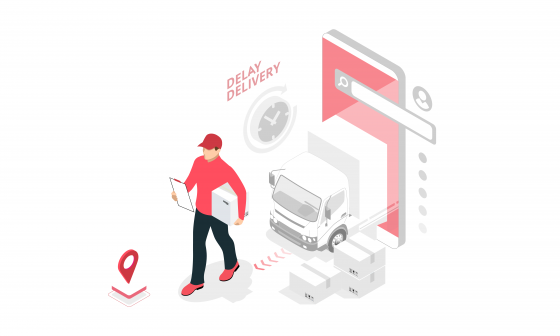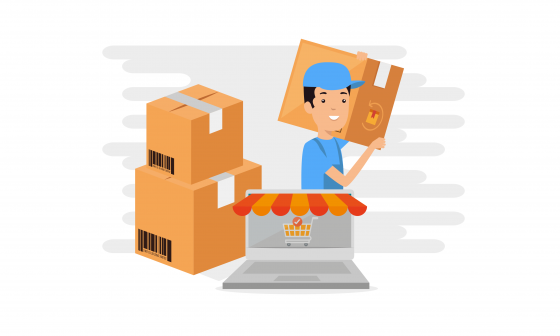According to Statista, the total U.S online retail sales were $123.39 billion in 2018.
With holidays, the opportunities to flourish are endless, but so is the opportunity for shipping error. For instance, just the last holiday season almost 16 million pieces of packages were delivered.
8% of those were delayed between UPS and FedEx alone.
Customers expect speedy, efficient deliveries. The single most essential task for online stores selling tangible products is order fulfillment. Bringing an effective eCommerce shipping strategy together is the first impactful step you will take to ensure your business thrives online. Shipping is one of the most vital points of differentiation for your brand and it’s important to let your customers know that you’re willing to go that extra mile to deliver an exceptional customer experience.
It may be a relatively simple approach like showing unmodified UPS or FedEx rates or offering free shipping across the board. But the most successful enterprises use carefully drafted strategic shipping options to increase margins. And the worst possible time to mess that up could be during the peak holiday sales season.
A shipping failure like a lost package may sour the customer and destroy the chance for repeat sales. This comprehensive, handy guide will help you hone your last-mile shipping strategy and customer service benchmarks to exceed holiday delivery expectations in 2019.
What does the eCommerce Holiday landscape look like?
Holiday eCommerce sales records have witnessed unprecedented growth. As online sales continue to radically outgrow brick and mortar retail growth, merchants need to invest in the post-purchase eCommerce experience.
- Cater to Mobile shopping: Smartphones in 2018 accounted for 31% of all sales. To maximize revenue during this season, you need to focus on optimizing your mobile capabilities with important features like enhanced in-app checkout options and highly personalized communication features. Push notifications can help navigate the holiday chaos successfully. Offering a quality shopping experience through mobile is vital to drive holiday sales.
- Balance the online and offline experience: It’s important to keep in mind that brick and mortar stores will be an important destination for online order pickup and also for shopping especially with merchants investing in omnichannel sales strategies. Thus the whole BOPIS (Buy-online-pickup-in-store) trend is likely to grow rapidly during the holiday season.
- Woo the last-minute shoppers: People tend to procrastinate. You have to be prepared. It’s highly likely that more than 40% of shoppers will wait until the last few weeks before Christmas to purchase gifts. You can cater to these demands better by removing the guesswork for gift-givers and by providing curated options.
- Crank up the speed of delivery: Nearly half of consumers expect you to deliver faster than you did a year ago. Online retailers every holiday season are pressed into providing faster delivery options in order to keep up with the ever-increasing demand from buyers and the competition. Delivery speed is a determining factor when it comes to purchasing. Supply chain professionals are well aware of the significance of speed.
What does the consumer shopping timeline look like?
The volume of holiday shipment rises later in the year but early weeks are still crucial. Planning your shipping strategy with affordable offerings earlier in the holiday season will allow your business to thrive by driving revenue and ensuring affordable shipping options for all your buyers. Online stores are open 24/7. Hence your website must be able to handle the influx of orders that come in during this time.
The holiday season includes 60 shopping days from late November to early January. However, critical days like Black Friday and Cyber Monday anchor the season. The influence of shopping on these three days is increasing shipping demands during the holiday season. From an organizational strategy standpoint, ensure your warehouse is equipped to meet the early demands.
While consumers procrastinate some also complete half their shopping by early December. The importance of Thanksgiving, Black Friday and Cyber Monday cannot be stressed enough. Shipping giants are increasingly offering higher discounts and using promotional incentives to push online sales during this time.
Develop your ideal holiday shipping strategy
Planning is everything.
First, take a step back and carefully analyze last year’s holiday performance like total shipping costs, best selling products, revenue numbers, busiest days during the season, priority countries and shipping restrictions if any. Your well-developed plan must include everything from inventory, promotions, staffing to an overall forecast of your sales channels.
Get creative with packaging
Ensure you are shipping packages devoid of damage. To do this, the first step is to choose the best packaging for your product. When it comes to inventory, base your procurement planning on last year’s industry trends along with your marketing budgets and quantities. In order to be fully prepared for any unexpected surges or delays ensure do include January and February in your inventory calculations.
Automate your shipping
You have to work out any issues before the holiday rush ensues and to do this testing shipping automation is imperative. Make things easier for your customer service department by having packing slips, tracking landing pages, tracking emails and other transactional messages created automatically and sent directly post-purchase. You must walk that extra mile to enhance post-purchase communications. Set up some shipping rules in order to set up a shipping shortcut and skip the negotiating process for rates.
Identify the ideal shipping solution for your business
Choosing and integrating with the right shipping carrier can have a big impact on revenue, delivery quality and arrival times.
USPS, UPS ,and FedEx accounted for more than 50 million deliveries each day for the 40 days between thanksgiving and new years eve in the United States alone.
The volume can be nerve-wracking for consumers and merchants alike. Additionally, consider how delivery times and rates are likely to change during this season.
UPS, FedEx, DHL have already released their estimated shipping deadlines for 2019.
Here’s the FedEx and UPS holiday schedule for Holidays 2019:
Source: ShipStation
When determining shipping rates for your customers, take into account how some carriers may have holiday shipping surcharges especially for bulky packages. It’s important to remember that when it comes to shipping to a global audience there can be no one size fits all courier.
Promote your holiday shipping offers
There are so many brands that usually don’t discount without diminishing brand value. But the holidays offer an incredible opportunity for these brands to do so. But this may lead to several ‘undercutting profitability’ issues. You need to take an approach that will help you find the balance between services that your customers want and a price that your business is happy with. Offering free shipping during this time makes a lot of sense for customers who are truly in “purchase mode” and are willing to justify their purchases.
If you are willing to offer free shipping you should be aware of your product margins, average order value, and actual shipping costs. You can finally offer discounts or free shipping for your popular products, integrating the shipping price with the listing price of your products and making it available to buyers who spend over a specific amount. Ensure your shipping threshold is at least 10% higher than your present average order value.
In order to handle deliveries efficiently, share and promote ‘ship by’ dates on your website for local and international buyers. Gentle reminders through strategic email marketing can ensure efficient deliveries before the holidays.
Your return policy shouldn’t be just an afterthought
Review your returns policy meticulously. However, the ideal thing would be to prevent returns. To do that show high-quality photos of your product on your website to manage customer expectations, include accurate size guides (it’ll be great if you offer guides that are localized by country) while receiving customer feedback and product reviews, be proactive.
Manage Delivery Exceptions
If your packages do happen to arrive late, it’s all on you to manage extremely unhappy and disgruntled customers. This is where refund and return policies play an increasingly important role. Make the policies visible on your site such as on your Checkout page or in the footer. Allow your customers to request easily and manage returns right from their dashboard. This will simplify the process, ensuring a seamless shopping experience for your consumers.
Be professional and empathetic to customers by offering a coupon or discounts. If your product was damaged make sure you offer your customer a replacement as an alternative to a refund. This may minimize your losses by retaining loyal customers.
It can be difficult to anticipate and prepare for every shipping problem that may or may not arise. But there are a few common eCommerce shipping mistakes that your business should avoid during the holiday season.
Prepare for the surge in order volume
One of the greatest shipping challenges you can face during the holidays is being overwhelmed with orders during peak selling periods and then not being able to fulfill them. It takes your warehouse employees a few minutes to pack, label and stack any order. This means if there are four employees working for eight hours a day each, you will be able to ship about 192 orders at full capacity per day. This is great until you have 300 orders. If you need to hire temporary workers, do that. If you need to have long shifts, do that. Do whatever it takes to ensure your lack of preparedness doesn’t ruin the holidays.
You may have enough workers and plenty of inventory but fall short on packing materials. If you have to ship 5000 orders during the holiday rush you will need 5000 boxes, 5000 labels and a good amount of tape.
Validate the shipping rates
Verifying rates is very important. To be absolutely certain, your eCommerce business should have a policy of regularly auditing its rate estimates that compares what the customer paid or was quoted to the actual shipping cost. If it’s an application programming interface that is providing your shipping quotes, ensure it simultaneously reflects your negotiated rates. You should also create an accurate rates table. A bad shipping quote, either too low or too high is detrimental to your business.
It is important to provide all-inclusive shipping quotes. Your customers may totally abandon their carts due to unexpected shipping costs during the checkout.
Shipping is central to the success of Holiday Sales
The holiday season is a time for celebration for shoppers and merchants alike. At the core of the shopping frenzy lies the deep imparted tradition of gift-giving and sharing happiness with near and dear ones. As retailers and shipping partners take the place of Santa’s reindeers, the onus of spreading joy is on them. It is only fair that retailers, eCommerce businesses and online stores deliver the holiday cheer on-time.
To ease retailers’ shipping anxiety during the holiday season 2019, AuditShipment offers to do the heavy lifting of monitoring their deliveries and optimizing their FedEx, UPS, and DHL shipping spend.
Auditshipment is an automated invoice audit that seamlessly reduces your shipping cost. With our service, you can receive shipping refunds for more than 50 carrier errors that include billing errors, late deliveries, and incorrect surcharges. With our expert shipping data intelligence, you can now easily monitor all shipping carrier errors and recover refunds in no time. Being true to our values, we strive to uphold yours with stellar services at an unbeatable pricing model. Our automated refund process is holistic and requires no programming or logistics knowledge.
Here’s to a Sizzling Holiday 2019!






